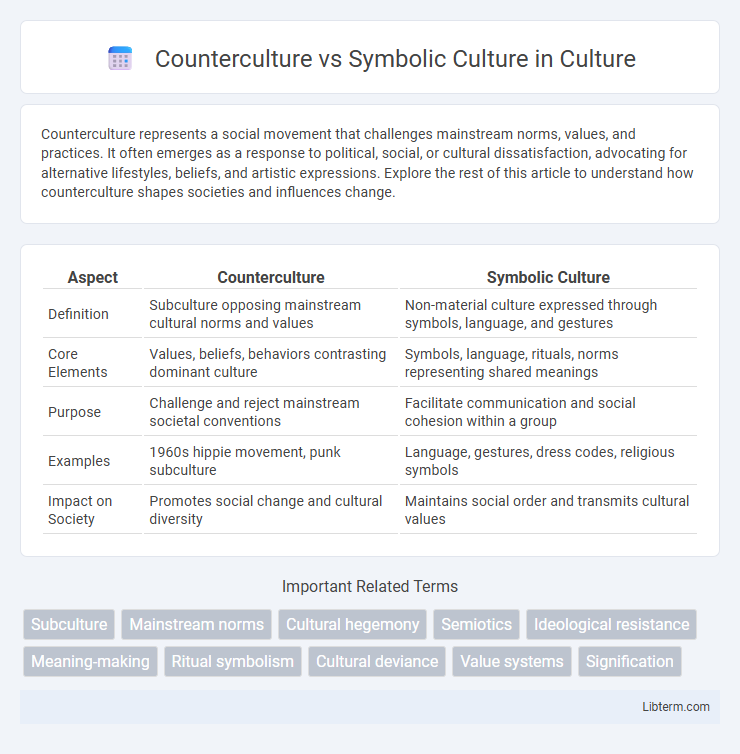Counterculture represents a social movement that challenges mainstream norms, values, and practices. It often emerges as a response to political, social, or cultural dissatisfaction, advocating for alternative lifestyles, beliefs, and artistic expressions. Explore the rest of this article to understand how counterculture shapes societies and influences change.
Table of Comparison
| Aspect | Counterculture | Symbolic Culture |
|---|---|---|
| Definition | Subculture opposing mainstream cultural norms and values | Non-material culture expressed through symbols, language, and gestures |
| Core Elements | Values, beliefs, behaviors contrasting dominant culture | Symbols, language, rituals, norms representing shared meanings |
| Purpose | Challenge and reject mainstream societal conventions | Facilitate communication and social cohesion within a group |
| Examples | 1960s hippie movement, punk subculture | Language, gestures, dress codes, religious symbols |
| Impact on Society | Promotes social change and cultural diversity | Maintains social order and transmits cultural values |
Introduction to Counterculture and Symbolic Culture
Counterculture represents a subgroup that rejects and opposes dominant societal norms and values, often seeking radical change or alternative lifestyles. Symbolic culture encompasses the shared meanings, symbols, language, and rituals that shape human interactions and social cohesion within a society. Understanding the contrast between counterculture and symbolic culture reveals how groups either challenge or reinforce cultural symbols and social structures.
Defining Counterculture: Origins and Evolution
Counterculture emerged prominently in the 1960s as a social movement challenging mainstream values, norms, and institutions, particularly in Western societies. Rooted in opposition to established cultural symbols, political policies, and social conventions, counterculture sought to create alternative lifestyles centered around freedom, peace, and artistic expression. Over time, counterculture evolved into diverse subcultures, influencing music, fashion, and political activism while reshaping societal attitudes towards authority and identity.
Understanding Symbolic Culture: Core Principles
Symbolic culture encompasses the non-material aspects of a society, including language, beliefs, values, norms, and symbols that convey meaning and facilitate social cohesion. Core principles involve the use of symbols as tools for communication, enabling individuals to interpret and respond to their social environment in shared ways. Understanding symbolic culture requires analyzing how these symbols shape identity, influence behavior, and reinforce social structures within both mainstream and countercultural groups.
Key Differences Between Counterculture and Symbolic Culture
Counterculture refers to a social group that actively rejects and opposes the dominant cultural norms, values, and practices, often promoting alternative lifestyles or ideologies. Symbolic culture comprises the symbols, language, gestures, and objects that carry particular meanings within a society, shaping communication and shared understanding. The key difference lies in counterculture's oppositional stance toward mainstream culture, while symbolic culture serves as the broader framework of meanings that all groups, including countercultures, use to express identity and social interaction.
Historical Examples of Counterculture Movements
Counterculture movements historically emerged as radical responses to dominant societal norms, exemplified by the 1960s Hippie movement opposing mainstream American values and the 1970s Punk subculture challenging established musical and social conventions. These groups rejected symbolic culture elements such as traditional dress, language, and rituals, creating alternative symbols that represented their ideologies and social critiques. The Civil Rights Movement also incorporated countercultural strategies by defying symbolic cultural norms through nonviolent protests, aiming to reshape societal values and legal frameworks.
The Role of Symbols in Shaping Culture
Symbols serve as the foundational elements in both counterculture and symbolic culture, shaping collective identity and social norms. In symbolic culture, shared symbols such as language, rituals, and art reinforce dominant cultural values and social cohesion, while in countercultures, alternative symbols challenge mainstream beliefs and promote divergent worldviews. The power of symbols lies in their ability to communicate meaning, influence behavior, and foster group solidarity across varying cultural contexts.
Cultural Conflict: When Counterculture Challenges Symbolic Norms
Counterculture movements challenge symbolic culture by rejecting established symbols, language, and rituals that represent mainstream societal values, leading to cultural conflict. This clash disrupts collective meanings and normalizes alternative ideologies, prompting social tension and debate over cultural definitions. The conflict often highlights power struggles between dominant groups who control symbolic norms and countercultural groups advocating for identity and value transformation.
Impact of Counterculture on Mainstream Society
Counterculture movements challenge prevailing norms and values, often sparking social and political change that gradually alters mainstream culture. By promoting alternative lifestyles, ideologies, and practices, countercultures influence fashion, music, language, and attitudes toward authority within broader society. These shifts contribute to the evolution of symbolic culture, redefining shared meanings and cultural symbols over time.
Intersections: How Counterculture Influences Symbolic Culture
Counterculture movements profoundly shape symbolic culture by introducing alternative values, symbols, and practices that challenge mainstream norms, leading to the evolution of societal meanings and identities. Iconic symbols such as the peace sign and punk fashion originated within countercultures before becoming integrated into broader symbolic culture, reflecting shifting social attitudes. These intersections demonstrate a dynamic process where countercultures redefine cultural symbols, influencing language, art, and collective memory across generations.
Future Trends in Cultural Change and Symbolism
Future trends in cultural change reveal a growing convergence between counterculture and symbolic culture as digital platforms amplify diverse symbolic expressions challenging mainstream norms. Symbolic culture evolves rapidly through virtual reality and augmented reality technologies, enabling immersive experiences that reshape identity and social values. Countercultural movements increasingly leverage these symbolic tools to contest dominant narratives and foster alternative worldviews, signaling a dynamic interplay shaping global cultural landscapes.
Counterculture Infographic

 libterm.com
libterm.com